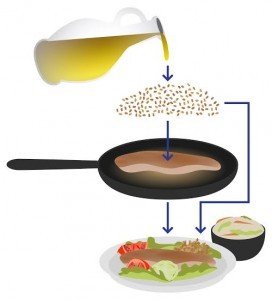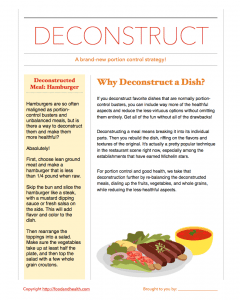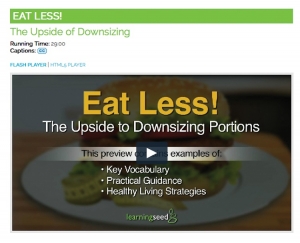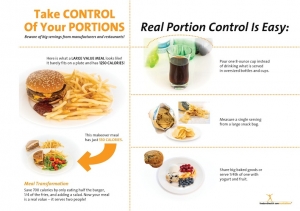Portion Control: Deconstructed
Looking for a new way to make portion control appealing to your clients? Try deconstructing dishes! If you deconstruct favorite dishes that are normally portion-control busters, you can include way more of the healthful aspects and reduce the less-virtuous options without omitting them entirely. Get all of the fun without all of the drawbacks!How Can I Deconstruct a Meal?Deconstructing a meal means breaking it into its individual parts. Then you rebuild the dish, riffing on the flavors and textures of the original. It's actually a pretty popular technique in the restaurant scene right now, especially among the establishments that have earned Michelin stars.For portion control and good health, we take that deconstruction further by re-balancing the deconstructed meals, dialing up the fruits, vegetables, and whole grains, while reducing the less-healthful aspects. Let's take a look at a few examples...Deconstructed Meal #1: Fried Chicken
If you deconstruct favorite dishes that are normally portion-control busters, you can include way more of the healthful aspects and reduce the less-virtuous options without omitting them entirely. Get all of the fun without all of the drawbacks!How Can I Deconstruct a Meal?Deconstructing a meal means breaking it into its individual parts. Then you rebuild the dish, riffing on the flavors and textures of the original. It's actually a pretty popular technique in the restaurant scene right now, especially among the establishments that have earned Michelin stars.For portion control and good health, we take that deconstruction further by re-balancing the deconstructed meals, dialing up the fruits, vegetables, and whole grains, while reducing the less-healthful aspects. Let's take a look at a few examples...Deconstructed Meal #1: Fried Chicken A typical plate that's loaded with a few pieces of fried chicken, coleslaw, and macaroni and cheese can be a portion control disaster, but there's a way to enjoy all the fun without totally overdoing it. Plus, the new presentation could be more elegant and creative than the original dish!Instead of frying the chicken, bake or sauté it. Choose a chicken breast for the best protein/fat ratio. Then toss some breadcrumbs with olive oil or butter and bake them until they get nice and crispy. Scatter them over the chicken or pile them next to it. Then make a lighter slaw, like this Cole Slaw or this Apple Slaw. Skip the macaroni or replace it with a traditional salad for an extra nutrient boost.Deconstructed Meal #2: Hamburgers
A typical plate that's loaded with a few pieces of fried chicken, coleslaw, and macaroni and cheese can be a portion control disaster, but there's a way to enjoy all the fun without totally overdoing it. Plus, the new presentation could be more elegant and creative than the original dish!Instead of frying the chicken, bake or sauté it. Choose a chicken breast for the best protein/fat ratio. Then toss some breadcrumbs with olive oil or butter and bake them until they get nice and crispy. Scatter them over the chicken or pile them next to it. Then make a lighter slaw, like this Cole Slaw or this Apple Slaw. Skip the macaroni or replace it with a traditional salad for an extra nutrient boost.Deconstructed Meal #2: Hamburgers Hamburgers are so often maligned as portion-control busters and unbalanced meals, but is there a way to deconstruct them and make them more healthful? Absolutely!First, choose lean ground meat and make a hamburger that is less than 1/4 pound when raw. Skip the bun and slice the hamburger like a steak, with a mustard dipping sauce or fresh salsa on the side. This will add flavor and color to the dish. Then rearrange the toppings into a salad. This Cherry Tomato Salad takes most of what you'd use to top a burger and re-portions them into a hearty and nutrient-rich side salad. Make sure the vegetables take up at least half the plate, and then top the salad with a few whole grain croutons.Voila! A deconstructed burger that has more nutrients and fewer empty calories!Deconstructed Meal #3: Key Lime Pie
Hamburgers are so often maligned as portion-control busters and unbalanced meals, but is there a way to deconstruct them and make them more healthful? Absolutely!First, choose lean ground meat and make a hamburger that is less than 1/4 pound when raw. Skip the bun and slice the hamburger like a steak, with a mustard dipping sauce or fresh salsa on the side. This will add flavor and color to the dish. Then rearrange the toppings into a salad. This Cherry Tomato Salad takes most of what you'd use to top a burger and re-portions them into a hearty and nutrient-rich side salad. Make sure the vegetables take up at least half the plate, and then top the salad with a few whole grain croutons.Voila! A deconstructed burger that has more nutrients and fewer empty calories!Deconstructed Meal #3: Key Lime Pie A typical slice of key lime pie can contain upwards of 450 calories, most of which are devoid of fiber or nutrients. Turn that around by deconstructing key lime pie!In this new version, add some fresh fruit for a blast of vitamins, minerals, and fiber. I like to start with berries like blueberries, strawberries, and raspberries, but tropical fruits like pineapple and mango are great options too.Next to that base of fruit, arrange 2 or 3 small baked meringues. Then top the fruit with a dab of lime sorbet or lime pie filling and sprinkle graham cracker crumbs over the plate. It really makes an elegant presentation, and the nutrient profile is much more robust than a traditional slice of pie.If you like what you see, get the handout for free! This downloadable PDF features a deconstruction guide and a sample menu from this post. Get your copy today!
A typical slice of key lime pie can contain upwards of 450 calories, most of which are devoid of fiber or nutrients. Turn that around by deconstructing key lime pie!In this new version, add some fresh fruit for a blast of vitamins, minerals, and fiber. I like to start with berries like blueberries, strawberries, and raspberries, but tropical fruits like pineapple and mango are great options too.Next to that base of fruit, arrange 2 or 3 small baked meringues. Then top the fruit with a dab of lime sorbet or lime pie filling and sprinkle graham cracker crumbs over the plate. It really makes an elegant presentation, and the nutrient profile is much more robust than a traditional slice of pie.If you like what you see, get the handout for free! This downloadable PDF features a deconstruction guide and a sample menu from this post. Get your copy today! And for more great portion control resources, drop by the Nutrition Education Store! We are here when you want to look your very best right now, so here are the 3 top-selling portion control materials...
And for more great portion control resources, drop by the Nutrition Education Store! We are here when you want to look your very best right now, so here are the 3 top-selling portion control materials...




